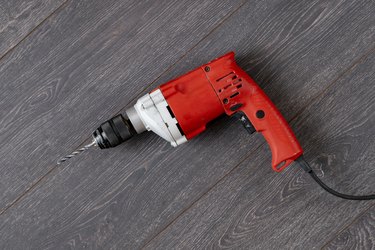
Your latest craft adventure requires punching holes in the project material — but there's not a hole punch in sight. Instead of putting your plans on hold to buy an appropriate punch, create those with a DIY hole punch made from other items you may have in your toolbox, garage or crafting area.
Punching Through Stacks of Paper
Video of the Day
To create holes in a stack of paper or cardboard at least 1/8-inch thick, a drill and drill bit handle the task with ease. Stack the paper or cardboard atop another sheet of corrugated cardboard or a piece of scrap wood. Weigh the stack down with a heavy object such as a heavy book or a brick, without blocking the area requiring holes. Select a drill bit that matches the size hole you wish to drill — if unsure, find another piece of paper or cardboard with the correct hole size and measure it. Drill straight down through your project materials in the desired location. Make a dot with a pencil first on the top sheet, if precision is required. A drill also makes holes through thin sheets of craft plastic, leather and metal foils.
Video of the Day
Going Awl In
An awl — a pointed tool with a sturdy handle — punches holes equally well through paper, cardboard, fabric and plastic. Place the material requiring the hole atop several stacked pieces of corrugated cardboard or a thick sheet of shipping foam. Rest the cardboard or foam atop a hard, smooth surface — not your lap. Hold the awl vertically so its point touches the project piece where you wish to create the hole. Push the awl through a material such as a thin plastic sheet or cardboard, or use a hammer to hit the top of the awl, punching through thin metal or tough materials. Depending upon your craft material, you may have to snip or sand the backside around the hole to make it smooth.
Pins, Needles and Nails
Push pins, thick needles and nails may also be used to punch holes through paper, cardboard and other materials without nails. These items all create relatively narrow holes, which can be widened by placing a skewer through the hole once you puncture the project material. As with the awl method, place a protective barrier such as corrugated cardboard or shipping foam beneath the project piece before poking the holes in your material. The tip of a craft knife may also be used to poke holes through thin material such as paper or fabric.
Hole Punch Alternative
A set designed for creating eyelets or adding grommets to fabrics can also be used to punch holes in thin materials such as leather, plastic and paper. An eyelet punch often features a number of dyes or posts on a wheel, set into a tool that looks a bit like pliers. Select the desired hole size, slide the paper or project material between the tool's jaws; then squeeze the jaws to make the hole. Other versions work like a punch-and-die set, requiring you to hammer the metal punch piece atop the project material to create the hole.